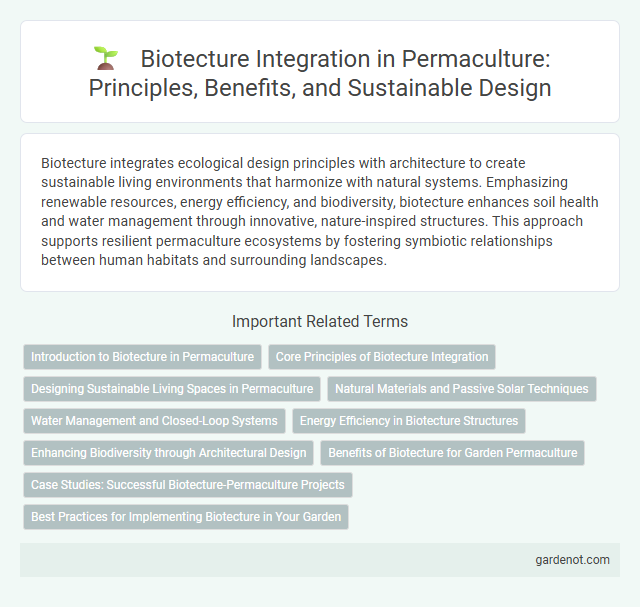Biotecture integrates ecological design principles with architecture to create sustainable living environments that harmonize with natural systems. Emphasizing renewable resources, energy efficiency, and biodiversity, biotecture enhances soil health and water management through innovative, nature-inspired structures. This approach supports resilient permaculture ecosystems by fostering symbiotic relationships between human habitats and surrounding landscapes.
Introduction to Biotecture in Permaculture
Biotecture in permaculture integrates ecological building principles with sustainable design to create self-sufficient, energy-efficient habitats that work harmoniously with natural ecosystems. It emphasizes the use of renewable resources, passive solar energy, and natural materials to minimize environmental impact while maximizing comfort and productivity. This approach fosters resilience and regenerative living by blending architecture with permaculture ethics and patterns.
Core Principles of Biotecture Integration
Biotecture integrates core principles such as natural materials utilization, energy efficiency, and symbiotic relationship between built structures and ecosystems. It emphasizes designing buildings that mimic natural processes, promoting sustainability through passive heating, cooling, and water management. By focusing on biomimicry, waste reduction, and habitat preservation, Biotecture fosters resilient living environments within permaculture systems.
Designing Sustainable Living Spaces in Permaculture
Biotecture integrates natural building materials such as cob, straw bale, and reclaimed wood to create sustainable living spaces that harmonize with the environment. Emphasizing passive solar design, water conservation systems, and natural ventilation, it enhances energy efficiency and reduces ecological footprints. Permaculture principles guide the spatial arrangement to support biodiversity, soil regeneration, and resource cycling within built environments.
Natural Materials and Passive Solar Techniques
Biotecture integrates natural materials such as rammed earth, straw bale, and bamboo to create sustainable, energy-efficient structures that harmonize with the environment. Passive solar techniques in biotecture optimize building orientation, thermal mass, and natural ventilation to reduce reliance on artificial heating and cooling systems. This approach enhances energy conservation while promoting ecological balance and occupant comfort.
Water Management and Closed-Loop Systems
Biotecture integrates permaculture principles by designing buildings and landscapes that optimize natural water cycles through rainwater harvesting, greywater recycling, and efficient irrigation systems. Closed-loop systems in biotecture ensure minimal waste by recycling water within the site, enhancing sustainability and reducing reliance on external water sources. This approach supports resilient ecosystems, improves water conservation, and fosters self-sufficient habitats.
Energy Efficiency in Biotecture Structures
Biotecture structures integrate natural materials like earth, straw, and timber to enhance insulation and reduce energy consumption significantly. Passive solar design, thermal mass, and natural ventilation optimize temperature regulation, minimizing reliance on mechanical heating and cooling systems. Energy-efficient biotecture contributes to sustainable living by lowering carbon footprints and promoting ecological balance.
Enhancing Biodiversity through Architectural Design
Biotecture integrates natural ecosystems within architectural design to enhance biodiversity by creating habitats that support diverse flora and fauna. Incorporating green roofs, living walls, and natural water systems fosters ecological corridors that promote species interaction and resilience. This approach not only improves environmental health but also contributes to sustainable urban development and climate adaptation.
Benefits of Biotecture for Garden Permaculture
Biotecture enhances garden permaculture by integrating living structures that promote natural cooling, improved air quality, and biodiversity. These sustainable buildings use natural materials like earth, straw, and timber, reducing environmental impact and supporting ecosystem balance. Incorporating biotecture elements within permaculture gardens fosters resilience, energy efficiency, and a harmonious relationship between human habitats and nature.
Case Studies: Successful Biotecture-Permaculture Projects
Case studies of successful biotecture-permaculture projects demonstrate innovative integration of sustainable building materials like rammed earth and straw bale with passive solar design, resulting in energy-efficient, eco-friendly habitats. Projects such as the Earthship communities in New Mexico and the Masanobu Fukuoka-inspired farms in Japan showcase effective water harvesting, onsite food production, and natural waste recycling systems. These models emphasize resilience, low environmental impact, and harmonious coexistence with local ecosystems while promoting community self-sufficiency.
Best Practices for Implementing Biotecture in Your Garden
Incorporating biotecture principles in your garden involves using natural building materials like cob, straw bales, and reclaimed wood to create eco-friendly structures that blend with the environment. Prioritize passive solar design, rainwater harvesting systems, and green roofs to enhance energy efficiency and promote biodiversity within your garden ecosystem. Applying these best practices fosters sustainable living, reduces environmental impact, and creates a harmonious space for both plants and wildlife.
Biotecture Infographic

 gardenot.com
gardenot.com